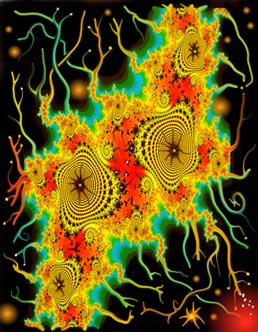
This Article From Issue
January-February 2003
Volume 91, Number 1
DOI: 10.1511/2003.11.0
Information Arts: Intersections of Art, Science, and Technology. Stephen Wilson. xxiv + 945 pp. MIT Press, 2002. $49.95.
In 1959, C. P. Snow's influential lecture "The Two Cultures and the Scientific Revolution" warned of a growing gap between science and technology on the one hand, and the arts and humanities on the other. With the advent of the Scientific Revolution and then the Industrial Revolution, society gave increasing weight to pure and applied scientific research, leaving the arts and humanities in a sort of cultural limbo. Lack of communication across this divide resulted in general cultural impoverishment and in the long run increased the risk of cultural and economic stagnation.

In Information Arts, artist Stephen Wilson, who is a professor at San Francisco State University, reexamines the relationship of art to scientific and technological research. He attempts to demonstrate that the gulf between the two cultures is finally closing, thanks to a newly shared dependence on information. At the beginning of the book, he notes that
Anthropologists claim that we increasingly live in an "information society" in which the creation, movement, and analysis of ideas is the center of cultural and economic life. In our culture, scientific and technological information is a critical core of that information.
What emerges from Wilson's book is not that the two cultures are merging or collapsing into each other. Rather, technoscience has come to permeate our society so deeply that the arts have been forced to respond: They are expanding their boundaries to include a new art form, homologous to scientific research and based on the collection, elaboration and circulation of bits and pieces of information.
Wilson's reasoning is as follows: Scientific and technological advances are deeply influencing and modifying our perceptions of nature, culture and ourselves, affecting both our daily life and our perspective on the future. We need be aware of these radical social and cultural transformations and of our participation in them. But we are overwhelmed by the amount, the obscurity and the rate of change of the information we have to deal with. The arts can and must play a fundamental role in filtering, translating and commenting on this information, and in guiding technoscientific research. And on the cutting edge of contemporary art, the arts are indeed trying to play that role.
Information Arts is an extensive compendium of the work of the many artists who use science or technology as a tool or a conceptual framework. But the book is also an attempt to define and promote a new kind of art that depends on vigilant observation of technoscientific culture and the world of research. Wilson has organized a vast amount of material into sections, first on scientific research—biology, the physical sciences, mathematics—and then on technological research—kinetics (conceptual electronics, sound installation and robotics), telecommunications and digital systems. He takes us on a thought-provoking journey through the field of technoscientific investigation as perceived by an emerging group of artist-researchers.
Although the overall structure of the book suggests a separation between science and technology, Wilson often makes no distinction between the two. Each section begins with a broad theoretical overview of a specific technoscientific area and then describes related art projects. Quotations from scientists, critics and artists are woven into this material very effectively. The descriptions of the art projects are minimal, but World Wide Web addresses are included where the works themselves or supplemental information can be found. The result is an incredibly rich hypertext. Unfortunately, some of this is already vanishing as these links begin to expire.
Wilson tells us that he tried in the book to stay on "a middle road between wariness about the subtexts and delight in the new possibilities." But he often ends up quite uncritically on the "delight" side. For example, in a discussion of how information about genetic engineering might "enter into the conceptualization and practice of art," he declares that
Notions that were once science fiction . . . are now almost accessible. Peer into the brains and hearts of yourself and others. Change your sex. . . . Clone yourself. Create a new organism. Enhance your intelligence, sex drive, life expectancy, mood, whatever. If these actions can be initiated for science, entertainment, or commerce, why not for art?
Unfortunately, Information Arts is not particularly sensual or visually striking: None of the illustrations are in color, and many are low in resolution. Perhaps Wilson and his publisher thought that the availability of much of this material on the Web made it unnecessary to include high-quality reproductions in the book itself. Or do they believe that sensual impact is unimportant in the experience of information art?
Near the end of the book, Wilson briefly describes his own role as a typical information artist:
Periodically, as part of my art practice, I discipline myself to ponder each article in a given issue of a science journal . . ., asking a set of questions: What is the article really about? What are the scientific and cultural contexts of the research? What might an artist do to investigate the concepts or processes of that research?
In this newly developing art form, the need for human expression comes after the need for information. Are the arts then really meeting the sciences through information, or are they just becoming information themselves?—Alice Benessia, Philosophy and Physics, Columbia University
American Scientist Comments and Discussion
To discuss our articles or comment on them, please share them and tag American Scientist on social media platforms. Here are links to our profiles on Twitter, Facebook, and LinkedIn.
If we re-share your post, we will moderate comments/discussion following our comments policy.